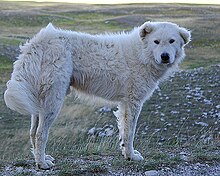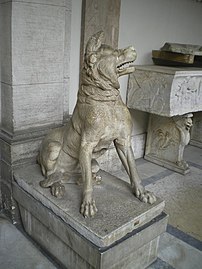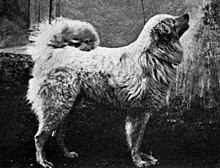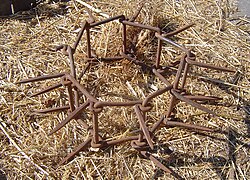
The Komondor, also known as the Hungarian sheepdog, is a large, white-coloured Hungarian breed of livestock guardian dog with a long, corded coat.
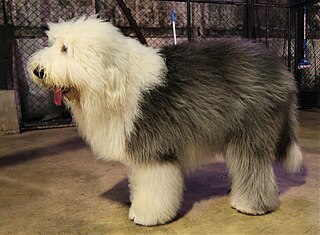
A sheep dog or sheepdog is generally a dog or breed of dogs historically used in connection with the raising of sheep. These include livestock guardian dogs used to guard sheep and other livestock and herding dogs used to move, manage and control sheep and other livestock.
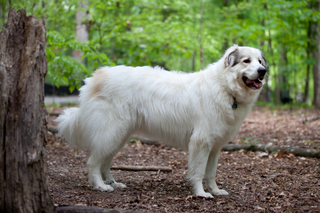
The Pyrenean Mountain Dog or Chien de Montagne des Pyrénées is a French breed of livestock guardian dog; in France it is commonly called the Patou. It originates from the eastern or French side of the Pyrenees Mountains that separate France and Spain and is recognised as a separate breed from the Mastín del Pirineo or Pyrenean Mastiff from the Spanish side of the mountains, to which it is closely related.

A herding dog, also known as a stock dog or working dog, is a type of dog that either has been trained in herding or belongs to breeds that are developed for herding. A dog specifically trained to herd sheep is known as a sheep dog or shepherd dog.

The Pyrenean Sheepdog, the Chien de Berger des Pyrénées in French, is a small to medium-sized breed of herding dog from the Pyrenees Mountains region of France. It is found herding flocks of sheep throughout the Pyrenees alongside the much larger Pyrenean Mountain Dog which is kept as a flock guardian.

The Bergamasco Shepherd, Italian: Cane da Pastore Bergamasco, is an Italian breed of sheepdog. It originated in the Alpi e Prealpi Bergamasche, where it was used as a herding dog for both sheep and cattle.
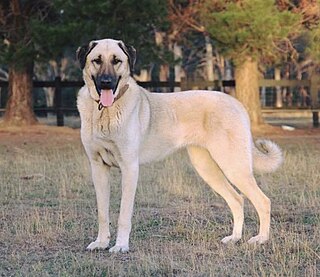
The Kangal Shepherd Dog is a traditional Turkish breed of large livestock guardian dog. The breed name derives from that of the town and district of Kangal in Sivas Province, the easternmost province of the Central Anatolia Region in central Turkey. The coat colour varies from pale fawn to wolf grey, always with a black mask.
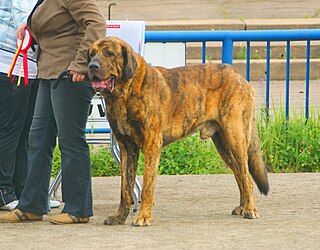
The Spanish Mastiff or Mastín Español is a breed of dog from Spain, originally bred to be a guard dog and whose specialized purpose is to be a livestock guardian dog protecting flocks and/or herds from wolves and other predators.

The Tatra Shepherd Dog, Polish: Polski Owczarek Podhalański, is a Polish breed of large flock guardian dog originating in the Tatra Mountains of the Podhale region of southern Poland. It was fully recognised by the Fédération Cynologique Internationale in 1963. It is one of five dog breeds originating in Poland, the others being the Polish Greyhound, the Polish Hound, the Polish Hunting Dog and the Polish Lowland Sheepdog.

The Himalayan Sheepdog, known locally by various names including the Bhote, Bangara or Gaddi Kutta, and sometimes called the Himalayan Mastiff, is a breed of livestock guardian dog from the Himalayas, covering India. The Himalayan Sheepdog is found in the Himalayan foothills from eastern Nepal to Kashmir. The breed is primarily used as a livestock guardian dog, protecting flocks of yak and sheep from various predators, and as a property guardian dog; unusually for a livestock guardian, the breed is also used to assist with herding. The Himalayan Sheepdog is also used to assist in hunting.
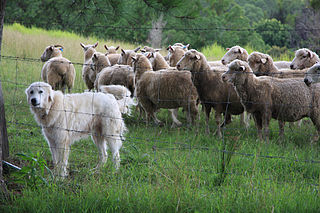
A livestock guardian dog (LGD) is a dog type bred for the purpose of protecting livestock from predators.

The Pyrenean Mastiff or Mastín del Pirineo is a Spanish breed of large livestock guardian dog from the autonomous community of Aragón in north-eastern Spain. It was traditionally used to protect flocks during the annual transhumance to high summer pasture in the Pyrenees. It is a distinct and separate breed from the Spanish Mastiff or Mastin Español and from both the Pyrenean Mountain Dog and the Pyrenean Shepherd.

The Cane Paratore is a breed of herding dog from Italy. The breed primarily exists in its traditional role in Abruzzo, its historical region of origin, having not gained popularity from outside dog fanciers.

The Cavallo Romano della Maremma Laziale, or "Roman horse of the part of the Maremma that is in Lazio", is a horse breed native to the Lazio region of Italy. An ancient breed, it was officially recognised only in 2010; it is now one of the fifteen indigenous horse "breeds of limited distribution" listed by the AIA, the Italian breeders' association. The Lazio region has assigned it the conservation status "at risk of erosion". The population numbers about 800, of which most are in the comune of Monte Romano in the province of Viterbo; a herd of approximately 200 is at Ponzano Romano in the province of Rome, and others are in the province of Rieti.
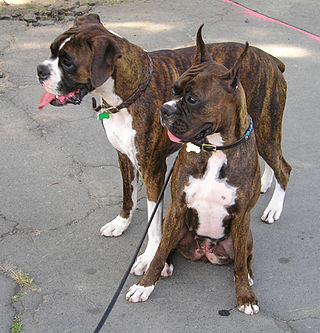
Cropping is the removal of part or all of the external flaps of an animal's ear. The procedure sometimes involves bracing and taping the remainder of the ears to train them to point upright. Almost exclusively performed on dogs, it is an old practice that was once done for perceived health, practical or cosmetic reasons. Veterinary science states there is no medical or physical advantage to the animal from the procedure, leading to concerns of animal cruelty over performing unnecessary surgery on animals. In modern times, cropping is banned in many nations, but is still legal in a limited number of countries. Where permitted, it is seen only in certain breeds of dog, such as pit bull and bull terrier type breeds, the Doberman Pinscher, Schnauzer, Great Dane, Boxer and Cane Corso.
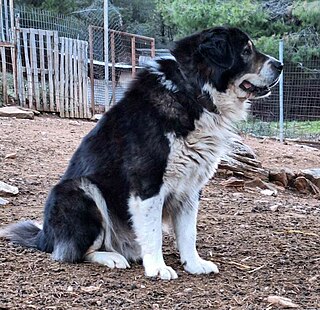
The Greek Shepherd or Greek Sheepdog is a breed of livestock guardian dog from Greece. Thought to be ancient in origin, the Greek Shepherd is very closely related to livestock guardian dog breeds from neighbouring countries; it is believed that some dogs are simultaneously claimed to be other breeds as they migrate annually across national borders with the flocks they protect in search seasonal pastures.

The Cão de Gado Transmontano or Transmontano Mastiff is a breed of livestock guardian dog from Portugal. It originates in the historical province of Trás-os-Montes e Alto Douro in north-eastern Portugal, and is a rare breed confined mostly to this area.
Abruzzo Sheepdog may refer to two closely related breeds of sheep dog widely used and likely originating in Abruzzo, Italy:

The Pastore della Lessinia e del Lagorai is an old Italian dog breed from the northeastern region called Triveneto. It is not recognized by any major kennel organisation.
